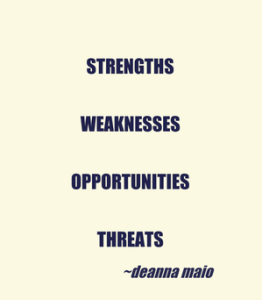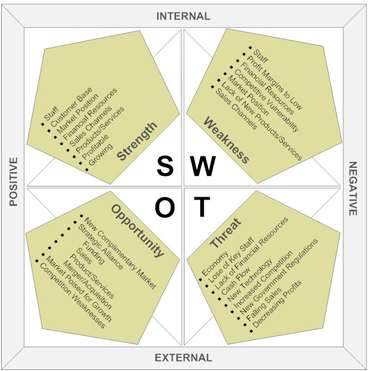Every MBA student will have studied SWOT at some point. SWOT, or “Strengths, Weaknesses, Opportunities and Threats” is a classical yet still effective tool for analyzing competition and your business. By doing a SWOT analysis, you can analyze your business in a very systematic way.
 Here are the basics of how to do a SWOT analysis.
Here are the basics of how to do a SWOT analysis.
==> Strengths
In what arena is your company particularly strong? How does that play out in the marketplace?
Look for strengths that can’t be emulated by your competitors and try to build a “moat.” In other words, try to create a competitive advantage that competitors can’t possibly steal.
==> Weakness
On the other hand, it’s equally important to know what your weaknesses are. If you don’t have an eye on your weaknesses, it’s easy to get blindsided.
For example, say your weakness is customer support. You just don’t have the cashflow to hire 15 more support staff at $1,500 a month.
If you’re aware of this weakness, you can implement systems like a knowledge base, live chat or other such tools to help reduce the amount of support requests you get.
If you’re not aware of the weakness, you’ll just provide bad support and alienate customers.
==> Opportunities
Successful businesses focus on opportunities, not urgent problems. In business, there’s always going to be urgent problems that need immediate attention. It’s the companies that can manage to stay focused on their opportunities that win out in the end.
Look for opportunities and identify ways you can take advantage of them. Lay out opportunities in each and every aspect of your business.
==> Threats
Keep an eye on your threats. These could include upcoming market changes, like new technology that could make your product obsolete. It could include new or existing competitors. It could even be internal; for example a growing rift between the marketing department and the product development department.
==> What Areas SWOT Encompasses
When you’re looking for strength, weaknesses, opportunities and threats, these are the areas you should assess:
* Marketing and outreach
* Management, personnel and talent
* Finance, cashflow and cash on hand
* Product positioning and price
* Brand and brand perception
* Intellectual property and patents
* Supply chain and supply costs
If possible, do a SWOT analysis for each category. This will give you a very in-depth analysis of all the most important aspects of your business.
==> Implementing Your SWOT Analysis
A SWOT analysis should be performed at least every six months. Upon completing a SWOT analysis, ask yourself: What’s the #1 highest leverage arena I could compete in today?
Craft an action plan around that answer. It could be based on leveraging a strength, fixing a weakness, exploiting an opportunity or mitigating a threat. Find the highest leverage activity and approach it head on.
And now I would like to invite you to claim your Free Instant Access to my special report…
“7 Tips to Get More From Your Work Time”
Yours free when you visit http://www.7TimeTips.com
You’ll learn:
- How and why to identify your most hated tasks.
- How to identify your biggest distractions – and eliminate them from your daily work life.
- Why setting goals is critical to your productivity success.
- The one thing you MUST do – even though it’s counter-intuitive – to ensure greater productivity.
- How to schedule tasks according to your own rhythms, so you can stop fighting with yourself and get more done.
We all want to get more done – but few of us really take the time to plan our workflow and make it happen. Take the first step with this short report and discover what it’s like to be truly productive. Just visit http://7TimeTips.com
From Deanna Maio – Systems & Implementation Strategist at http://DeannaMaio.com



Its very useful one for all MBA student , how to improve his business skills and it teach how to run business ethically. Strength, Weakness , Opportunity , Threats are very important for a man success. For a business man its life.
This is an amazing technique. Analyzing all possible angles of your business is key to success. Knowing strengths as well as your weaknesses helps give you an edge in a competitive market.
I'm looking forward to implementing this in my future.